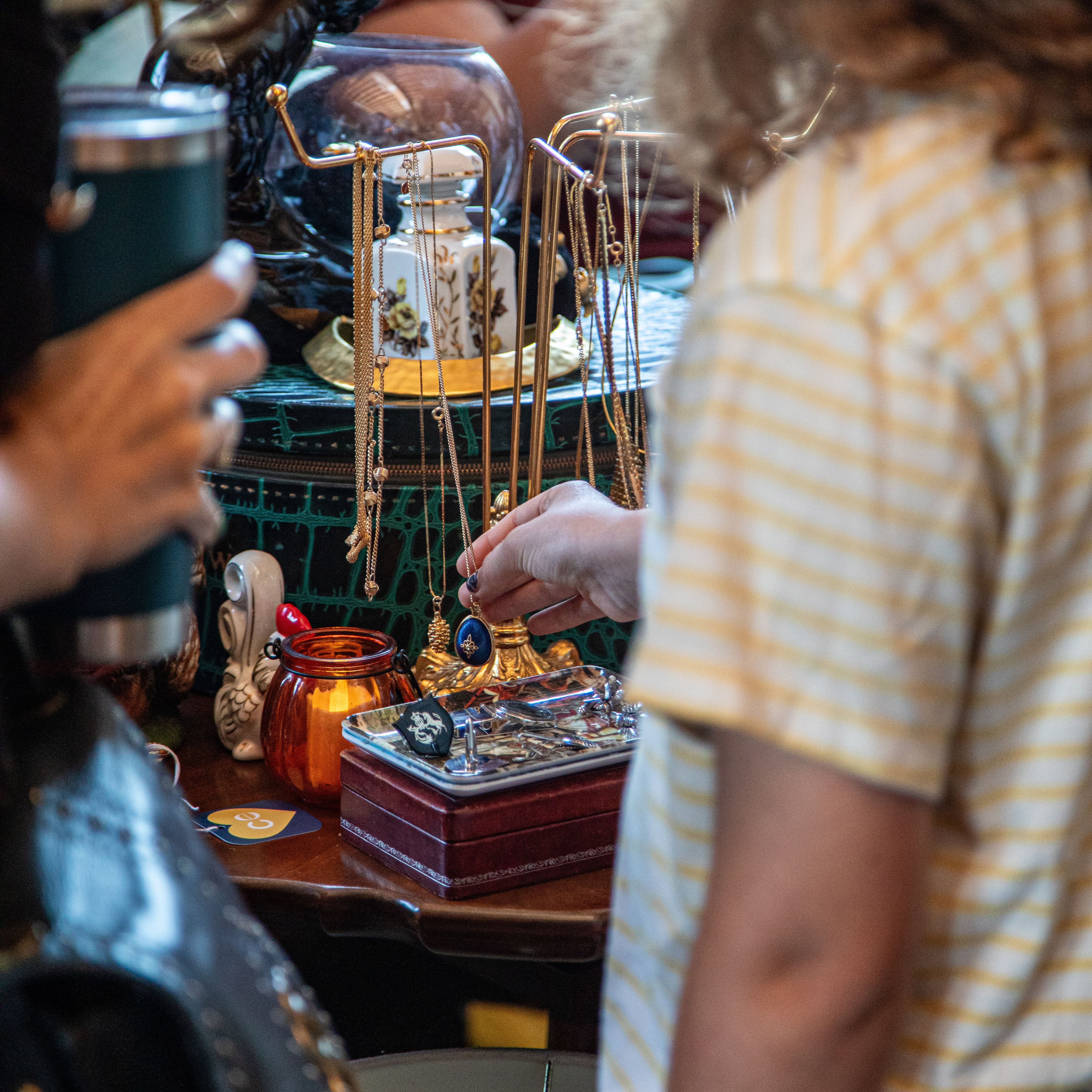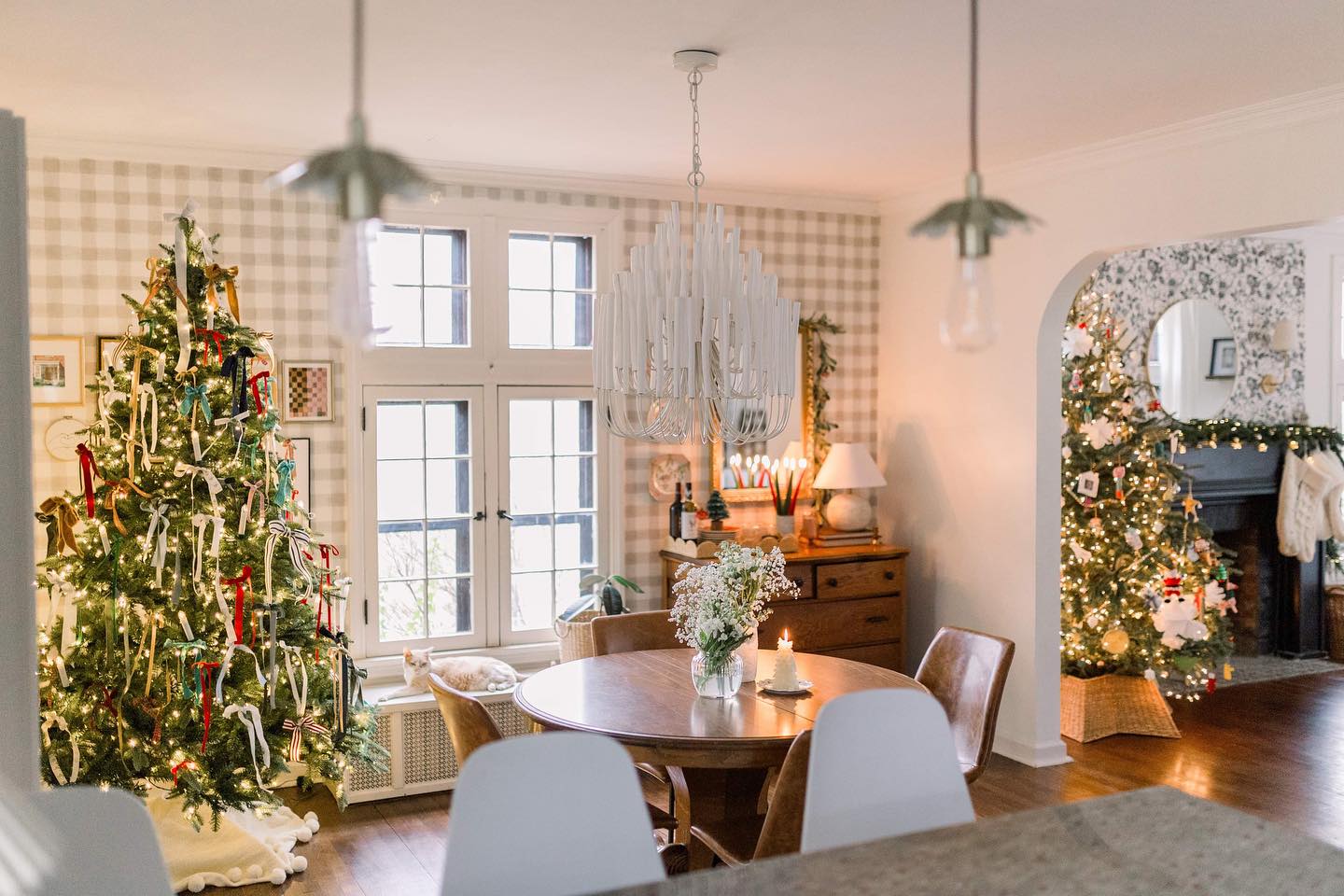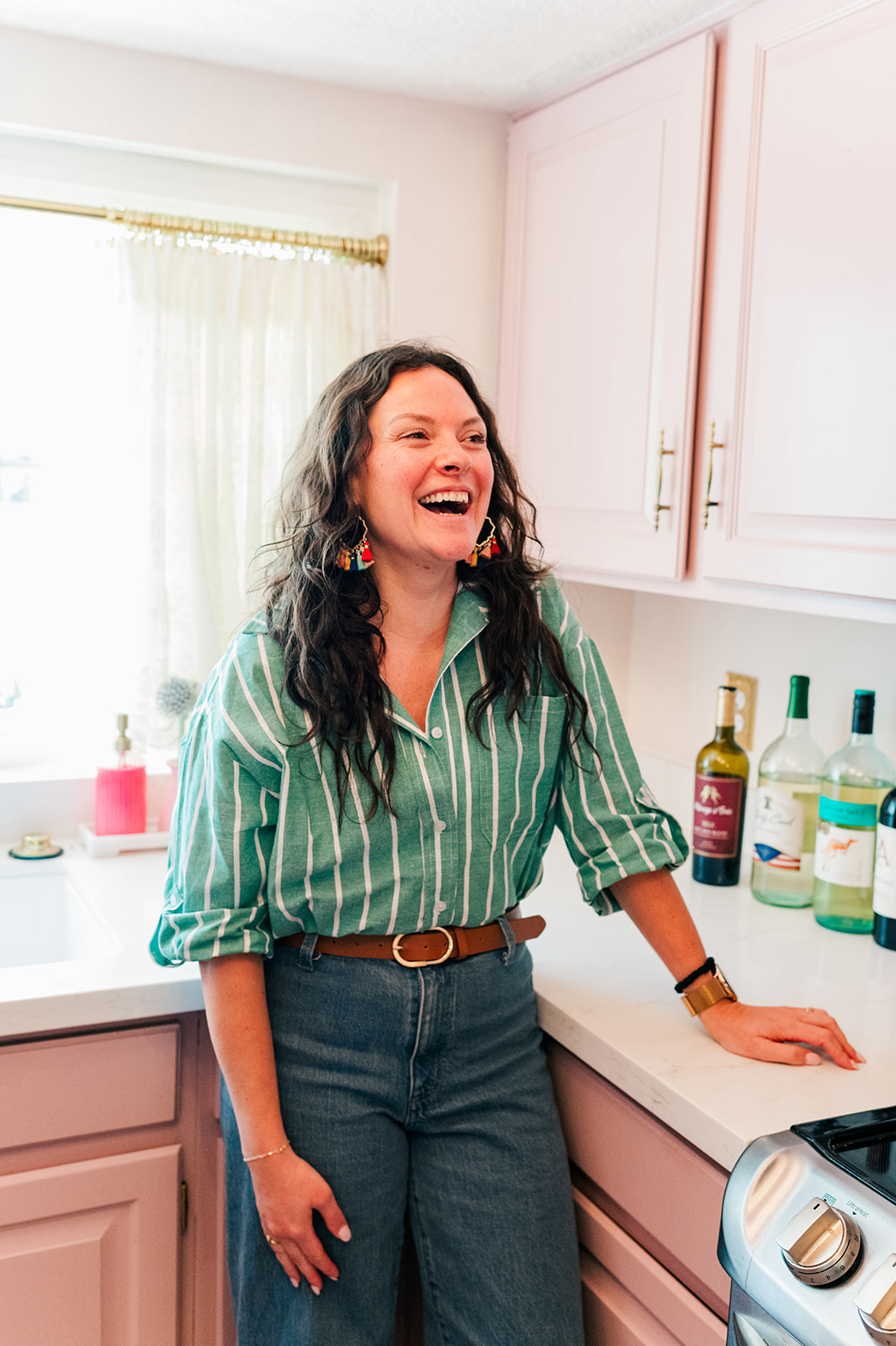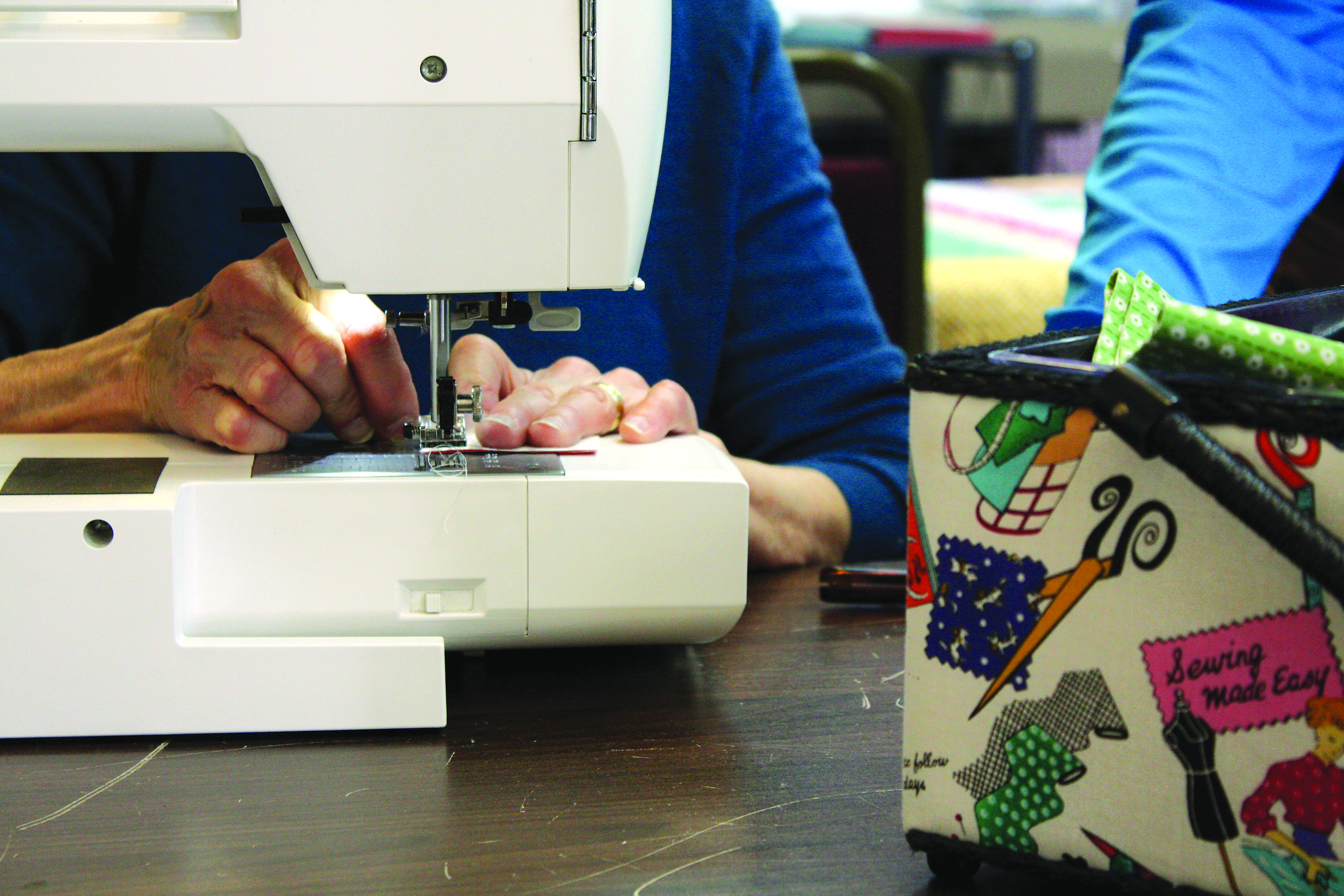Get ahead of the weekend by signing up for our free weekly “In the CLE” newsletter — your guide to fun throughout The Land. Arriving in your inbox every Wednesday, this weekend to-do list fills you in on everything from concerts to museum exhibits — and more. Click here to subscribe.
12 Outdoor Design and Patio Trends for Cleveland Homes
by Kristen Hampshire | Jun. 26, 2023 | 12:00 PM
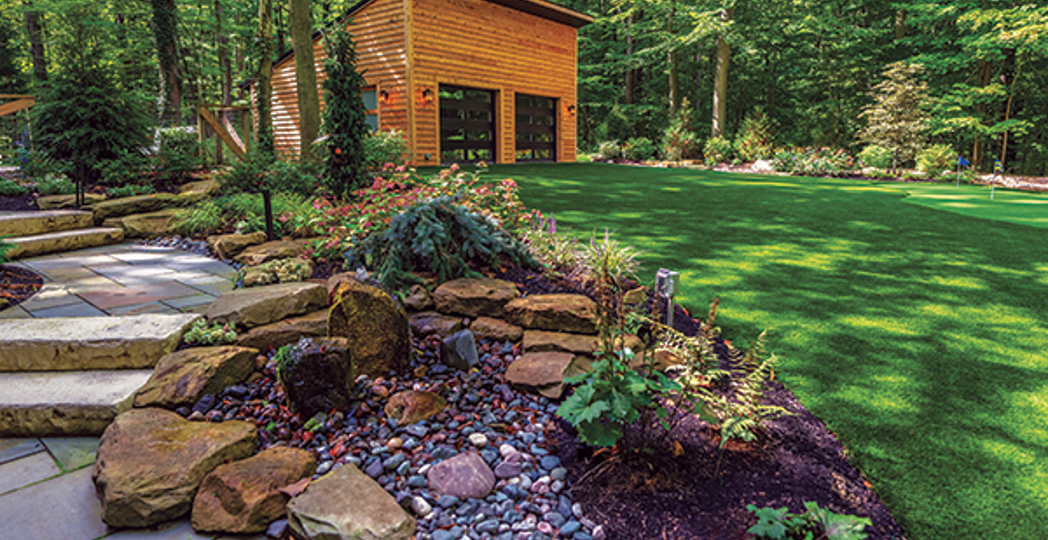
Courtesy Groundworks
Staycation vibes in the backyard are driving a rush of outdoor living projects that bring home everything from doggie spaces and putting greens to pavilions equipped with all the trappings to entertain.
“People are interested in investing the time and effort to make their homes somewhere they don’t need to leave and can create memories with families and friends,” says Dave DiGregorio, general manager at Ground Works Land Design in Westlake.
Sure, the pandemic played a role in jumpstarting landscape projects that might have been pushed to the back burner. It inspired a sort of “Why
not?” mentality. Why not put in a pool-hot tub hybrid with a bar ledge? Why not add a fire table to the patio? Why not reimagine the whole backyard since home is where the work/life is?
“People were home, looking at their yards and started to think about them in a different way,” says Jonas Pattie, president and co-owner, The Pattie Group in Novelty and Westlake. “Now, we are seeing a lot of master planning where we’re creating a design and installation for the whole yard, even if it is completed in phases over
several years.”
What’s the ROI on outdoor living projects? While industry statistics from the American Society of Landscape Architects point
to about a 15% increase in home value with professional work, anecdotally that number has increased a bit, DiGregorio says. “We are seeing over 100% returns on outdoor living spaces as it pertains to home value — and you also get the personal
value of using the space.”
Ready to turn your great outdoors into a space that suits your lifestyle? Here are 12 trending ways to do just that.
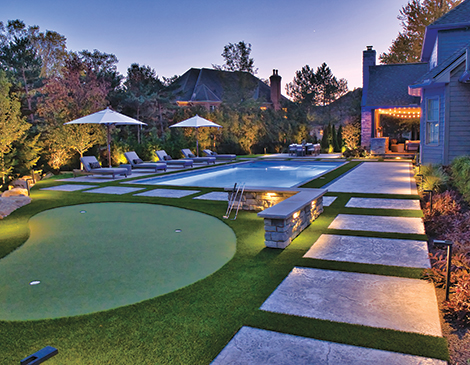
(Photo courtesy Groundworks)
Take a Plunge
Just add water. With a right-sized pool, you can dip your toes in or wade away from a stressful day. Not all backyards can support a typical-sized rectangular pool, which generally measures 35 feet
by 16 feet. However, rectilinear shapes are still the most popular, and Pattie says this is because “everyone wants the automatic pool cover — you turn the key, it closes and you’re done with it.”
Creative pool products on the market provide a mix of designs. There’s the smaller, multi-tasking “spool” spa pool that includes jets. Cocktail pools are usually about 12 feet by 14 feet and no deeper than 3 feet and are sometimes designed with built-in stools and a ledge to perch a beverage.
DiGregorio describes a cool pool build in Rocky River using a Modpool repurposed shipping container. It was installed as an in-ground pool that is completely recessed, but some are positioned so there’s a step up and into the pool, or it is set into a deck surround.
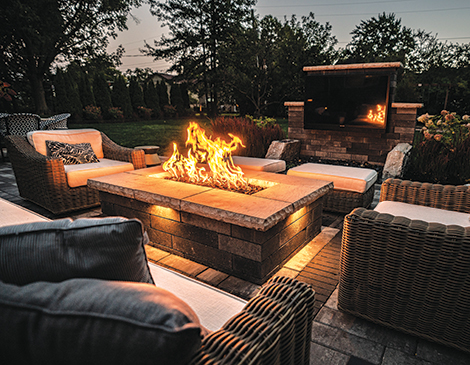
(Photo courtesy Groundworks)
Always Hot: Fire Features
In Northeast Ohio, fire pits are a perennial favorite. We can’t quite call them a trend because they’re always in, but there are fresh ways to infuse
warmth into outdoor living spaces. One of those is the fire table. “With outdoor kitchens or bars, a fire element is set into a granite table, so you can sit around the fire table — it looks really cool and functions nicely,” DiGregorio
says.
Fireplaces are also on the hot list.
And the traditional fire pit is still popular. “When they are gas-run with lava rock, you walk outside, pour a glass of wine, turn the key and your fire is running,” he says.
Don’t Forget Fido
Include your four-footed family members in landscape planning with a dedicated dog area that protects the rest of the lawn from damage while also offering a place to play. A dog’s outdoor space might include
artificial turf, river rock or a combination of materials. Fencing in the area contains the space.
“People love their dogs, and creating a park on your property can be as simple as some grass in a contained area to adding structures for the animals, or stone for drainage — materials that are more tolerant of dog use,” says Kurt Kluznik, president of Yardmaster Landscape Architects & Contractors based in Painesville. Yardmaster mainly works on commercial accounts such as multi-family communities.
Pet-friendly artificial turfs are permeable, DiGregorio adds. “Sometimes we work pet areas along the side of the house, fencing that in, and include artificial turf so the dog can run around and have a dedicated space.”
A “bark out” to other amenities: seating (for the two-legged family), a water source for refilling the bow — even a fountain feature or low-rider hose tap — and agility course setups. Make your own, check online or enlist in a pro. Don’t forget the shady areas to give your pooch a place to retreat from the sun. Landscaping or umbrella fixtures will do the trick.
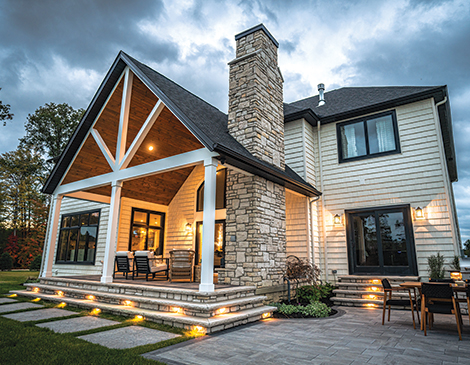
(Photo courtesy Groundworks)
Working Smarter
With a few taps on your smartphone app, you can basically control your outdoor environment. We’re talking lights, including color-changing LEDs that set the mood, and
sprinkler systems, pool heaters and covers, music and media.
Many Wi-Fi-enabled features are now financially accessible. “Technology-laden amenities also allow a company like ours to link in and manage an irrigation system to change run times, identify problems or shut down zones,” Pattie says, citing tasks that were once performed in-person only, requiring a technician on your property (and probably a fee).
Another biggie is automated screens to keep the bugs out of outdoor covered spaces. “With a push of a button, down go the screens,” Pattie relates.
What’s not so in demand are outdoor sound systems. “The outdoor sound system has taken a step back with Alexa and so many abilities to get quality portable speakers and stream music,” Pattie points out.
Seating Nooks
Carving out pint-sized places to enjoy a view or simply take a break has evolved beyond plopping a bench and calling it a day. Seating nooks might include a path leading to the space, a mini hardscaped patio that feels like
a getaway room away from the main entertaining area, and plantings to provide privacy, Kluznik says of a few different approaches.
More Color, Less Maintenance
Flower beds are getting more colorful than in previous years, notices Kluznik.
“We are getting away from some of the typical plant material like knockout roses or impatiens, and bringing in tropicals like banana trees, palms, oleander, elephant ears, ferns and moss gardens—more lush foliage,” he says.
Basically, the tropicals are treated like annuals so they’re not expected to thrive through winter.
Orange is a trending color — hold the marigolds. Instead, Kluznik is specifying hardy sunpatiens and Dragon Wing begonias.
Low maintenance is a steady ask from clients across sectors. “People are busy,” DiGregorio says simply. “They want landscape beds that look nice and are easy to take care of.”
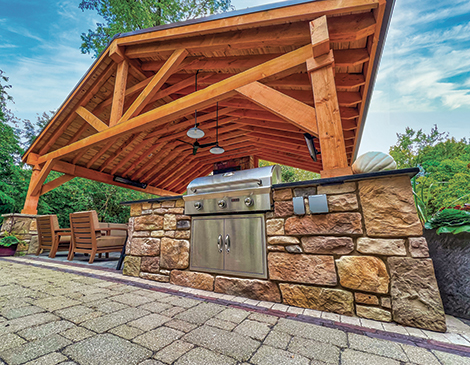
(Photo courtesy Groundworks)
The All-Out-Amenities Outdoor Kitchen
What’s “in” is out. Practically every appliance and fixing you can select for your home’s interior kitchen is available for
the outdoor version. “We are seeing sinks, fridges, smokers we can build in, more elaborate grills, flat-top-griddles and granite countertops,” DiGregorio says.
Also, portability is moving into the outdoor kitchen space in a big way. For instance, there was a stretch of time when constructing an official patio pizza oven was a luxury ask for high-end plans. But now you can spend less and regain space. (This is just one example.)
“Rather than spending to build an outdoor pizza oven, you can get a portable one that slides into the infrastructure that makes it easier, and you can bring it into the house during winter,” Pattie describes.
Fake Out — Artificial Turf
Erase images of the prickly, emerald indoor/outdoor carpet. Today’s advanced artificial turf looks and feels like the real deal, without the maintenance or mess that soggy springs and wet falls
bring to Northeast Ohio lawns. “The quality has come so far,” says DiGregorio. “You can walk on it with bare feet, and it feels great.”
Artificial turf is a win for dog areas, spaces where grass is just difficult to grow, and smaller patches of lawn abutting patios. Say goodbye to muddy feet and paw prints all over the house.
Plus, artificial turf introduces other recreational possibilities: the backyard putting green, which is a popular feature for golf enthusiasts. “The trend started out west in California and Arizona, and we have seen it come this way,” DiGregorio says.
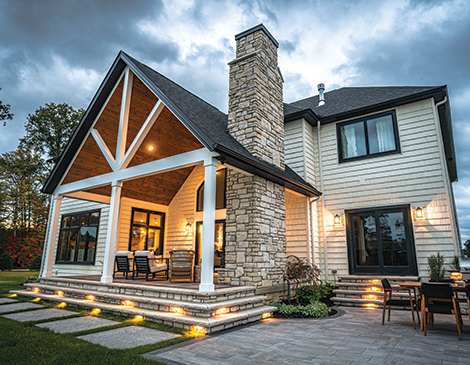
(Photo courtesy Groundworks)
Light It Up!
Once an afterthought, landscape and outdoor lighting has shifted to the priority list — though for landscape architects, this has always been the case. Lighting extends
the time you can spend outside, enhances elements like columns or rooflines on a home, and accents landscaping. There’s also the safety and security aspect of lighting.
In the most basic sense, strings of bistro lighting can be hung on arbors, pergolas and deck railing, Kluznik points out. “Those are high-impact, low-cost ways to enhance a property,” he says.
DiGregorio adds, “Bistro lighting is a great way to make your backyard space feel like a swanky restaurant.”
Under Cover
With most projects, Ground Works designs include a roof structure — a way to create a true outdoor living room space that can be equipped with a fireplace, mounted television, retractable screens, heating elements and,
of course, lighting. “It allows you to extend your outdoor living season,” DiGregorio says.
A pavilion can be attached to the home or freestanding. Pattie says the overhead structures they’re building are typically framed in lumber and wrapped in a weather-ready composite like AZEK.
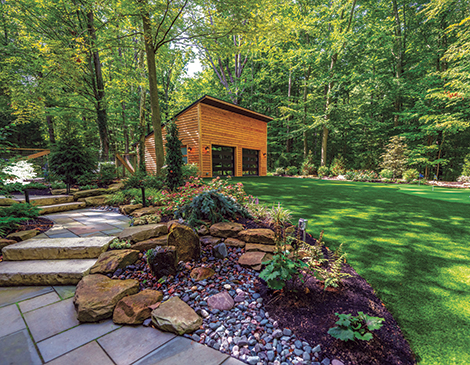
(Photo courtesy Groundworks)
Rein in Runoff — the Rain Garden
Multifamily properties are sometimes mandated to manage groundwater, and those dwelling in single-family homes are embracing how harvesting rainwater
can reduce soggy spots in the yard, prevent erosion, and filter pollutants to water before they potentially seep into the water supply. Officially, a rain garden is a vegetated, multi-layer setup. Think of a cake made from stone, vegetation, mulch
and sand. Each level catches the yucky stuff that water carries with it, along with reducing swampy backyard syndrome. In another vein, a pint-sized version of water capture is the readily available rain barrel. It is what it is. Rain barrels collect
runoff, so you can use it for watering plants.
Hide the Uglies
We’re not talking about scenic vistas. How are you handling the view of your trash and recycling bins, compost pile or neighbor’s always-open garage door? “People are becoming more visual and seeing that
whether or not it’s on your property, you’re looking out—so concealing utility areas is possible with well-placed plantings,” Kluznik says. “You don’t have to block it out, but you can interrupt that view, so your
eyes go to a new focal point—landscaping.”
Trending
-
1
-
2
-
3
-
4
-
5




